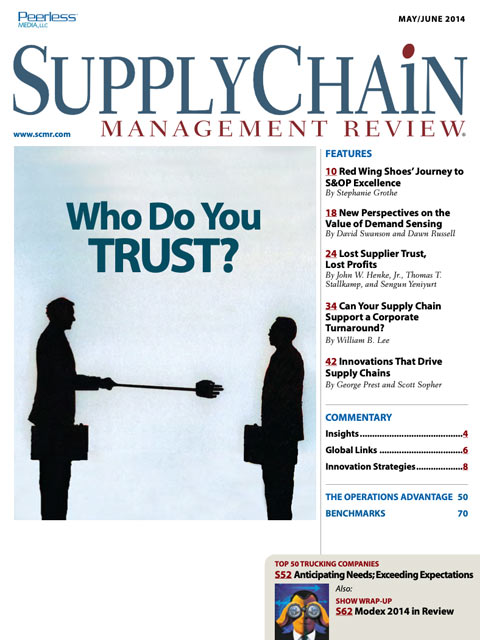Sorry, but your login has failed. Please recheck your login information and resubmit. If your subscription has expired, renew here.
May-June 2014
Getting the most from Sales and Operations Planning is a combination of people, processes, and technology. The Red Wing Shoe Company details the steps it took to improve S&OP processes, slash its S&OP planning efforts by 50 percent, and align manufacturing with sales—all while growing its business. Browse this issue archive.Need Help? Contact customer service 847-559-7581 More options
“Make vs. Buy” continues to be one of the most strategic decisions manufacturing companies can make in this day and age. Whether the motivations to outsource manufacturing are bottom-line focused, capital driven, or intended to improve the top-line, discussions with many companies across a range of industries indicate that manufacturing outsourcing is often falling short of expectations. A recent A.T. Kearney survey sheds some light on why there is still a sizeable gap between strategic intent and operational execution and how that gap can be closed.
Outsourcing Manufacturing
Companies have been outsourcing their manufacturing operations for a variety of reasons and across the ebb and flow of the economy. In bad economic times, reasons quoted are often lowering costs, shifting from fixed costs to variable costs, or transitioning products that are end-of-life away from prime internal assets.
When the economic tide is turning, reduced capital investment needed to alleviate capacity constraints, less working capital needed, and increased flexibility are the main drivers for outsourcing. And when times are good and growth is on the strategic agenda, companies often turn to contract manufacturing to provide them with faster speed-to-market, quick access to new markets, and improved customer responsiveness. Increasingly, we even see companies leveraging their contract manufacturers’ design and development capabilities as well as their expertise in specialized manufacturing processes to jointly pursue process and even product innovation.
 |
This complete article is available to subscribers
only. Click on Log In Now at the top of this article for full access. Or, Start your PLUS+ subscription for instant access. |
Not ready to subscribe, but need this article?
Buy the complete article now. Only $20.00. Instant PDF Download.
Access the complete issue of Supply Chain Management Review magazine featuring
this article including every word, chart and table exactly as it appeared in the magazine.
SC
MR
Sorry, but your login has failed. Please recheck your login information and resubmit. If your subscription has expired, renew here.
May-June 2014
Getting the most from Sales and Operations Planning is a combination of people, processes, and technology. The Red Wing Shoe Company details the steps it took to improve S&OP processes, slash its S&OP planning… Browse this issue archive. Access your online digital edition. Download a PDF file of the May-June 2014 issue.
 |
Download Article PDF |
“Make vs. Buy” continues to be one of the most strategic decisions manufacturing companies can make in this day and age. Whether the motivations to outsource manufacturing are bottom-line focused, capital driven, or intended to improve the top-line, discussions with many companies across a range of industries indicate that manufacturing outsourcing is often falling short of expectations. A recent A.T. Kearney survey sheds some light on why there is still a sizeable gap between strategic intent and operational execution and how that gap can be closed.
Outsourcing Manufacturing
Companies have been outsourcing their manufacturing operations for a variety of reasons and across the ebb and flow of the economy. In bad economic times, reasons quoted are often lowering costs, shifting from fixed costs to variable costs, or transitioning products that are end-of-life away from prime internal assets.
When the economic tide is turning, reduced capital investment needed to alleviate capacity constraints, less working capital needed, and increased flexibility are the main drivers for outsourcing. And when times are good and growth is on the strategic agenda, companies often turn to contract manufacturing to provide them with faster speed-to-market, quick access to new markets, and improved customer responsiveness. Increasingly, we even see companies leveraging their contract manufacturers’ design and development capabilities as well as their expertise in specialized manufacturing processes to jointly pursue process and even product innovation.
 |
SUBSCRIBERS: Click here to download PDF of the full article. |
SC
MR

Latest Supply Chain News
- How S&OP provides the answer to in-demand products
- AI, virtual reality is bringing experiential learning into the modern age
- Humanoid robots’ place in an intralogistics smart robot strategy
- Tips for CIOs to overcome technology talent acquisition troubles
- There is still work to do to achieve supply chain stability
- More News
Latest Podcast

 Explore
Explore
Latest Supply Chain News
- How S&OP provides the answer to in-demand products
- AI, virtual reality is bringing experiential learning into the modern age
- Humanoid robots’ place in an intralogistics smart robot strategy
- Tips for CIOs to overcome technology talent acquisition troubles
- There is still work to do to achieve supply chain stability
- Blooming success: The vital role of S&OE in nurturing global supply chains
- More latest news
Latest Resources

Subscribe

Supply Chain Management Review delivers the best industry content.

Editors’ Picks





